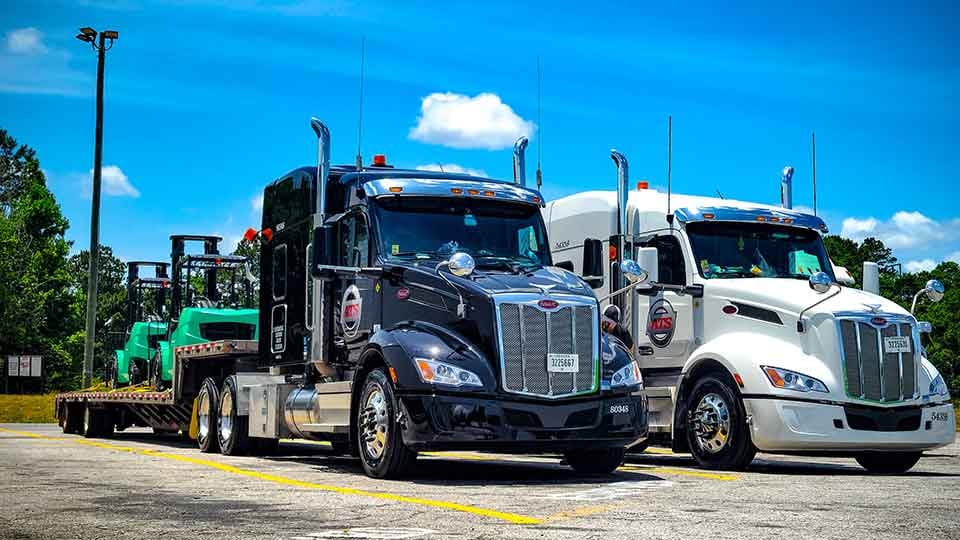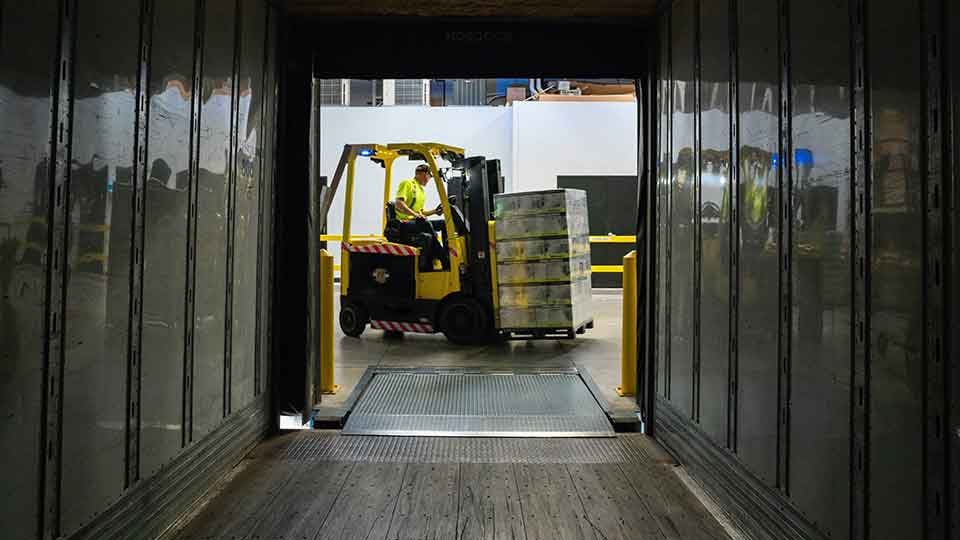Forklifts are incredibly useful tools in warehouses, on construction sites and in manufacturing plants. While they are great at lifting and moving heavy items, they are too slow to drive down the road.
This means that, like most goods, they need to be hauled on a truck.
Because of their size and weight, forklifts are harder to transport than, say, pallets of bricks (which, incidentally, are usually loaded onto a truck using a forklift).
Fortunately, as a full-service carrier, Anderson Trucking Service (ATS) has a diverse fleet of trailers, including vehicles capable of hauling pallets of bricks and vehicles capable of hauling forklifts. Our experience hauling forklifts has taught us some key best practices that make it possible to haul even the largest of them.
In this article, we will dive into forklifts, the complications with hauling them and possible solutions. Having that understanding will help you create an accurate shipping plan to move a forklift (or other heavy equipment).
Why Is It Hard to Ship a Forklift?
A forklift is a counterbalanced vehicle with large prongs (forks) on its front. The forks raise and lower, sometimes up to 10 feet high. Forklifts are used for everything from moving heavy objects (like pallets of bricks) to stacking things on warehouse shelves to towing smaller vehicles.
From that simple definition, there are multiple complicating factors, making it harder to ship forklifts (via semi-truck) successfully:
- There are forklifts designed specifically for diverse applications. From loading 5-foot shelves to pulling boats out of the water to transporting 100,000 pound concrete blocks. All these use-cases mean forklifts range in size between an average of 9,000 pounds to over 40,000 pounds They can also be anywhere from 3-feet square to 10 or more feet long.
- Forklifts are designed to roll (on everything from small tires to massive treads), which means keeping them in place during transit requires specialty bracing and securement.
- Counterbalanced vehicles do not have an even weight distribution, making them harder to secure.
The complications specific to transporting a forklift require special care and attention. Before booking a load, be sure your carrier has the knowledge and experience needed to ship a forklift.
How Do You Ship a Forklift?
Like most logistical projects, the best way to ship a forklift is…it depends. Your needs, the size of the forklift and the availability of the right truck will all play a role in determining the best shipping method for your forklift project.
Here are three additional factors that must be considered when shipping a forklift (or multiple):
1. Legal Axle Weight Limits
The size of the forklift may determine how it is transported.
Dry vans have a maximum weight capacity of about 45,000 lbs and can accommodate freight up to about 9 feet, 2 inches tall. Smaller forklifts that fit inside these parameters may be hauled in a dry van. Forklifts too tall to be transported in a dry van can have their masts and forks removed for transport inside a van, or they can be hauled on a flatbed trailer.
A standard flatbed is 5 feet high, leaving 8.5-9.5 feet of height (depending on where you are in the country) to haul a forklift (forks down, obviously). For taller forklifts, a step-deck trailer or low-boy will give you the additional height you may ship with or without a permit (as need be).
Some forklifts will not fit within legal load limits for weight or dimension. These forklifts will require permits to travel. Separate permits are required for each state and jurisdiction and are restricted to traveling during certain hours.
Certain types of heavy-duty forklifts, while within the legal load limit, will place extra stress on the floor of the trailer due to their combination of massive weight and compact size. When hauling forklifts of that size, it’s vital to ensure the floor of the trailer is sturdy enough to handle this weight without collapsing or causing damage.
Once the right vehicle has been chosen based on legal limits, it’s time to prepare the shipment.
2. Securing a Forklift for Travel
Within a dry van, most forklifts are secured with blocks and braces which are nailed to the trailer. Some dry van carriers will not carry forklifts because of the nails and holes left behind by this bracing, which may create problems for future loads.
Sometimes straps and chains are also added to keep the forklift from shifting or moving during transit. If straps and chains are used, the person doing the bracing will use padding to prevent friction and possible damage to the forklift itself.
If you are specifying a forklift to transport in a dry van, be specific that you are shipping a forklift that will require blocks and braces. Being transparent about this requirement means you can avoid surcharges that may be added if the carrier provides a vehicle that can’t accommodate your freight.
Because forklifts are relatively compact for their weight, where they sit on the trailer is important. Keep these things in mind:
- If transporting multiple forklifts, the driver will space them out evenly to keep the weight balanced.
- When traveling with just one forklift, the driver will balance it near the center of the trailer to keep the trailer level during travel.
- The forklift should be centered side-to-side to keep in balance during transit.
Securing the forklift keeps everyone (and everything) on the road safe. The size and shape of a forklift complicates securing the load…fortunately, those complications make it easy to load and unload.

3. Loading the Forklift for Transit
Loading the forklift onto a trailer is probably the least complicated part of the process. Forklifts, like most self-propelled vehicles, can be driven onto a trailer — from a loading dock or ramp — in many instances.
When the forklift is on the truck, it will be secured for the drive. Some shippers have personnel who are specially trained in block and brace securements who will secure the load, and sometimes it is done by the driver. The driver is always responsible for inspecting securements to prevent property damage or injury during transit.
Once they arrive at the destination, forklifts play an important role in transportation.
Using Forklifts When Loading/Unloading Trucks
As a vital piece of equipment in most warehouses, forklifts are used to load and unload trucks. The forklift operator maneuvers the forks into the slots on a pallet of commodity, deposits it onto a truck and then backs away. The next pallet is either forked next to the first pallet, or the operator raises the forks to stack it on top. The process then repeats as needed until the vehicle is packed with pallets.
While they do simplify the process, forklifts are not required to load and unload trucks. Here are some alternatives:
- Warehouse staff can use pallet jacks to move packed commodities.
- Handtrucks or dolly carts can roll smaller quantities of freight onto a truck. This is common for less-than-truckload (LTL) or smaller shipments.
- Self-driving equipment can drive on from a loading dock (just the same way a forklift is loaded and unloaded).
- Cranes are often used to load freight at job sites and manufacturing facilities.
For a full truckload of palletized dry van freight, there’s no faster way to load/unload than by using a forklift. If your consignee does not have a forklift, it may be tempting to send a forklift along with the freight. However, most forklifts will not be able to balance properly at the back of the truck (where it will be most useful for unloading). The consignee can use a pallet jack or dolly, or rent a forklift if it is necessary for unloading at their end.
What You Need to Know Before Shipping a Forklift
Without understanding how forklifts are shipped and the complicating factors, you may have encountered a carrier who simply declined a load. Having a basic understanding of how forklifts are shipped will help you find the best carrier partner.
In order to create a proper plan for shipping, you will need to know the following information:
- The exact size (length, width, height) and weight of the forklift. This information may be available in the original specifications, or you can carefully measure if you have the equipment to do so. The fork should be slightly tilted up for ultimate safety during travel.
- The number of forklifts you’re shipping and the measurements of each.
- The destination and origin points. This will help the carrier determine not only the mileage and travel time but also legal height limits and what permits, if any, are required.
- How the forklift will be secured. Before the driver arrives onsite, it is important to know who will secure the forklift and how it will be done. Specifying this from the beginning of the process ensures that the proper equipment and driver are assigned to the load.
- If the forklift must be covered during transit. Dry vans, tarping or Conestoga trailers can provide protection from the elements.
Forklifts are great at moving heavy objects into, onto, out of and around trucks. And with a proper detailed plan, they can be moved any distance to a new job site or warehouse.
Choosing the right carrier is vital when shipping a forklift (or, frankly, anything that’s important to you). You can also simplify the process by understanding the nuances of your project and creating an accurate specification sheet. While shipping forklifts comes with some unique challenges, at the end of the day a thoughtful and reliable carrier will be able to help.
See if ATS is the right contact for you.

